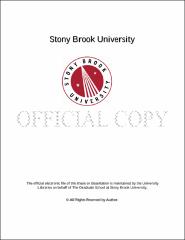| dc.identifier.uri | http://hdl.handle.net/11401/76092 | |
| dc.description.sponsorship | This work is sponsored by the Stony Brook University Graduate School in compliance with the requirements for completion of degree. | en_US |
| dc.format | Monograph | |
| dc.format.medium | Electronic Resource | en_US |
| dc.language.iso | en_US | |
| dc.publisher | The Graduate School, Stony Brook University: Stony Brook, NY. | |
| dc.type | Thesis | |
| dcterms.abstract | Thermohaline circulation is responsible for the global transport of heat in surface waters of the ocean, and variability in this circulation has been linked to both short- and long-term climate change on time scales ranging from centuries to tens of thousands of years. Accurate reconstructions of past variability are thus critical to understanding modern and future thermohaline circulation changes and the response of the global climate system. The main circulation feature in the Atlantic is Atlantic Meridional Overturning Circulation (AMOC), and has been reconstructed using a variety of static proxies, but more recently through the use of sedimentary <super>231</super>Pa<sub>xs</sub>/<super>230</super>Th<sub>xs</sub>. The ratios of these radionuclides through time provide a relative rate of circulation based on the uneven scavenging efficiencies of <super>231</super>Pa and <super>230</super>Th in the water column, and hence provide a measure of the speed at which the waters flow through the Atlantic basin. However, the <super>231</super>Pa<sub>xs</sub>/<super>230</super>Th<sub>xs</sub> proxy has been shown to inaccurately depict AMOC variability when biogenic opal comprises a significant component of the overall particle flux. This study will present the biogenic opal and <super>231</super>Pa<sub>xs</sub>/<super>230</super>Th<sub>xs</sub> records preserved in Bermuda Rise sediments for the majority of the Holocene epoch (~9 kya-present, based on radiocarbon-dated planktonic foraminifera). The location of the Bermuda Rise and its extremely high sedimentation rate allow for millennial-scale sampling resolution to examine the relationship between biogenic opal flux and sedimentary <super>231</super>Pa<sub>xs</sub>/<super>230</super>Th<sub>xs</sub>. Stable oxygen and carbon isotope data from planktonic foraminifera will also provide a climate context for the sediment record. Results reveal a significant correlation (p < 0.05) between <super>230</super>Th<sub>xs</sub>-normalized opal flux and <super>231</super>Pa<sub>xs</sub>/<super>230</super>Th<sub>xs</sub> through the Holocene, but the statistical significance is driven by the sample taken at the core-top. Without this sample the records are no longer significantly correlated (p > 0.05), supporting the use of <super>231</super>Pa<sub>xs</sub>/<super>230</super>Th<sub>xs</sub> as a proxy for paleocirculation at the Bermuda Rise over the interval of study minus the surface layer. The surface sample-driven correlation implies that there is a compositional effect of biogenic opal in the most recently-deposited sediments, a hypothesis supported by a benthic foraminiferal δ <super>13</super>C record of a nearby core. It is unclear at this time whether the increase in opal flux was produced locally or the result of lateral silica transport to the Bermuda Rise. The surface samples are also characterized by a bioturbated mixed layer which muted the signal of well-known Holocene climate events such as the Little Ice Age (~400 ybp) and the Medieval Climate Anomaly (~1 kya). Interpretation of the remainder of the <super>231</super>Pa<sub>xs</sub>/<super>230</super>Th<sub>xs</sub> record as unbiased changes of AMOC variability indicate that circulation through the Holocene was relatively stable with the exception of an interval of slightly weakened circulation from ~5700-4100 ybp. Although comparisons with several other paleocirculation proxies from nearby Bermuda Rise cores were ambiguous, it is beneficial to learn that <super>231</super>Pa<sub>xs</sub>/<super>230</super>Th<sub>xs</sub> ratios are a reliable proxy through the majority of the Holocene at this site. | |
| dcterms.available | 2017-09-20T16:42:19Z | |
| dcterms.contributor | Cochran, J. | en_US |
| dcterms.contributor | Black, David E | en_US |
| dcterms.contributor | Flagg, Charles. | en_US |
| dcterms.creator | King, Theresa Marie | |
| dcterms.dateAccepted | 2017-09-20T16:42:19Z | |
| dcterms.dateSubmitted | 2017-09-20T16:42:19Z | |
| dcterms.description | Department of Marine and Atmospheric Science. | en_US |
| dcterms.extent | 85 pg. | en_US |
| dcterms.format | Monograph | |
| dcterms.format | Application/PDF | en_US |
| dcterms.identifier | http://hdl.handle.net/11401/76092 | |
| dcterms.issued | 2014-12-01 | |
| dcterms.language | en_US | |
| dcterms.provenance | Made available in DSpace on 2017-09-20T16:42:19Z (GMT). No. of bitstreams: 1
King_grad.sunysb_0771M_12017.pdf: 3085985 bytes, checksum: cffb5ebfc61b031098bb4d30301e9d44 (MD5)
Previous issue date: 1 | en |
| dcterms.publisher | The Graduate School, Stony Brook University: Stony Brook, NY. | |
| dcterms.subject | Paleoclimate science | |
| dcterms.subject | 231Pa/230Th, AMOC, Bermuda Rise, Holocene, Opal, Paleocirculation | |
| dcterms.title | The influence of biogenic opal on 231Pa/230Th in sediments from the Bermuda Rise and its implication for paleocirculation reconstructions | |
| dcterms.type | Thesis | |

